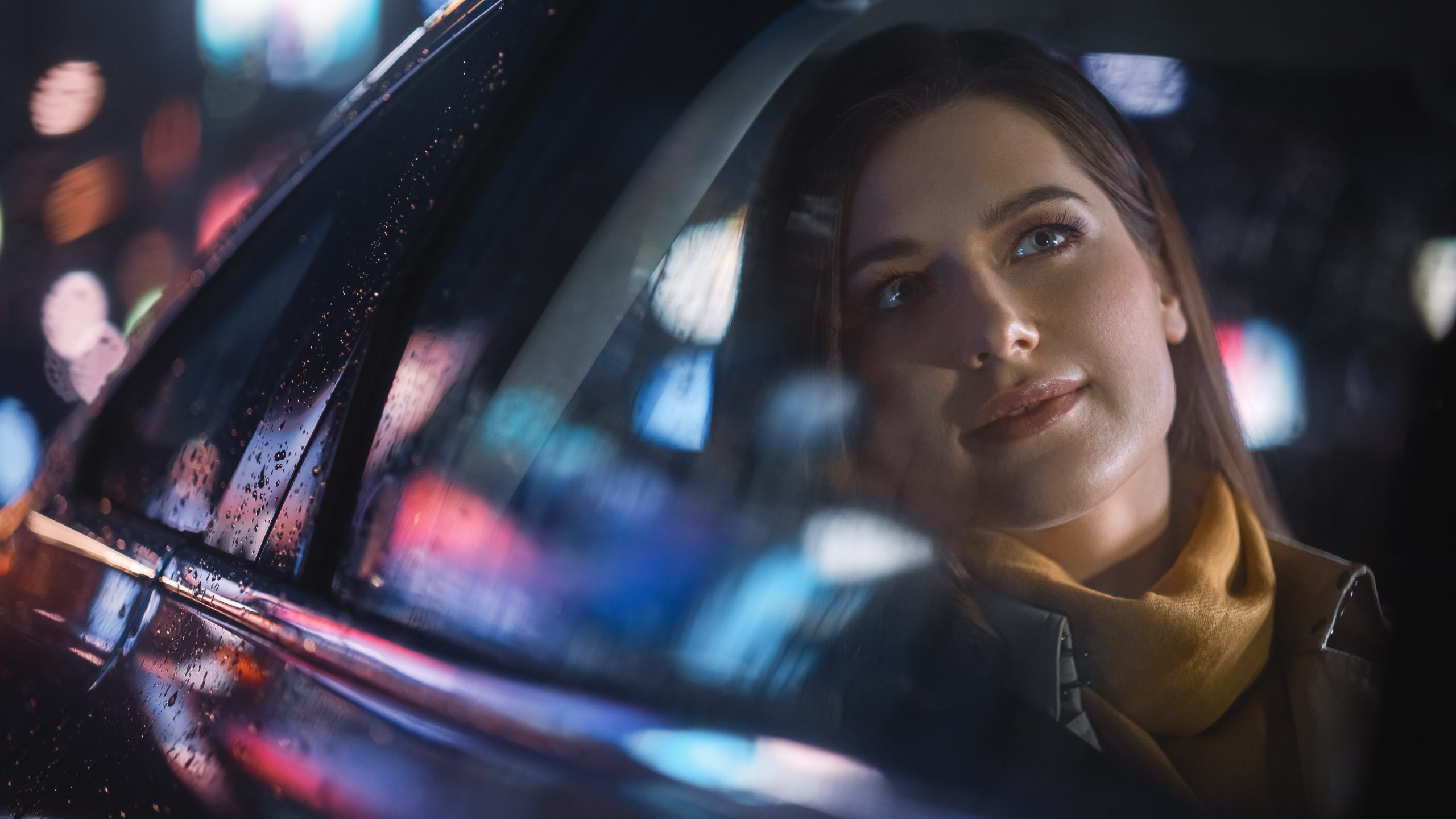
Edward Robles’ “TESLA” is not a commercial. It’s the opposite. Not that these cars are yet capable of what happens with them in the film, but with A.I. taking over many facets of our existence, it might not be long before it’s possible. The film isn’t really about the cars, though, so much as it is about the status of owning one. It is also about the unintended consequences of actively combating the climate crisis (more on that later). Some have said that cars are an extension of one’s personality, and in Robles’ film, owning a Tesla is the right to treat everyone as if they don’t own a Tesla and are therefore expendable.
The unnamed owner of this Tesla (Jonathan Medina) gets in his car one morning while talking with a co-worker about the need to get rid of people in the company who are dragging down the existence of those higher up (namely, him). As he enters the automobile, the computer informs him of an automatic software update, then gives him a mountain of legal text for him to either look at “Later” or “Accept.” We catch glimpses of the contract, which have some red flags hidden in the text, but Medina’s character has no time for that, clicks the “Accept” button, and proceeds.
What happens after that I’ll leave for you to discover, but “TESLA” might have you thinking about its intentions and its result and whether or not the two meet successfully. The victims in this are not obvious and add a layer of complexity that would otherwise make it another topical tale screaming its message at us. It is easy to view it as cautionary against technology, A.I., the greedy, and the heartless, and it has that, but Robles smartly lets the film be its own “Twilight Zone” episode and leaves you to figure out what to take from it. It’s not about Elon Musk and the selfishness he perpetuates among his followers. It’s about people like Musk, their need for control at all costs, and who will inadvertently carry out the plan.
Robles’ film is tight, well-cast, and darkly funny in a few spots. It reminds me of another “Black Mirror”-esque short I wrote about years ago called “Strange Beasts,” which foretold an augmented reality program designed to be interactive entertainment, with the side effect of losing one’s grip on actual reality. That film was uploaded to Vimeo six years ago. Watching it now, it feels more in the moment. I hate to think of “TESLA” looking quaint and dated six years from now, but depending on how you view it, its time may have already arrived.

How did this come about?
This film began bubbling to the surface near the end of my time as a Tesla owner, as I started coming to terms with what I saw as the back-patting vanity of driving a Tesla. Don’t get me wrong: I think electricity is the future, and decarbonizing transportation will play a huge role in how our species saves itself from total destruction. But I began seeing Tesla ownership as an empty gesture. Some people own Teslas and take ten transatlantic flights a year. Some people own Teslas and work for egregious polluters. Owning a Tesla does not absolve you of your carbon sins. I had an urge to convey that truth.
At the same time, driving around in my (former) Tesla, I was always enamored with the giant touchscreen in the center of the dash. When you’re driving, the touchscreen shows you a virtual simulation of the car and its immediate surroundings: other cars, people, and bicyclists. Teslas get software updates over the air, so sometimes you’ll get in your car and find out it learned something new. For instance, one day, I got in, and the car excitedly told me it can now recognize orange cones. For a few weeks, everything was an orange cone. Sidewalk? Orange cone. Kid crossing the street? Orange cone. Fire extinguisher? Yep, orange cone.
So I decided to put two and two together: why not make a film about radical accountability in the hour of the climate crisis by way of a software update run amuck?

I’m curious about the Teslas in the film. What kind of deal did you have to make to get them? Or are we looking at digital trickery?
No digital trickery! These are real Teslas. The white one was mine (since sold). The others are owned by friends and friends of friends. In LA, you can throw a rock and hit ten Teslas, so it wasn’t terribly hard to wrangle a few for the shoot.
How did you find Medina?
I found Jonathan through a mutual actor acquaintance. I was looking for a great Latino actor, put the word out, and was told I had to meet this guy.
A long time ago, I resolved to work with more Latino leads. I’m half Latino though I present as a run-of-the-mill white guy. But growing up in and around heavily Latino Chicago neighborhoods, I felt there was a huge delta between the people I knew in my life and how Latinos were represented on screen. You just don’t see very many roles for Latinos, let alone leads. The few reliable roles always seem to be gangster, drug lord, soldier, and immigrant. This dearth of representation can have an effect on how people see themselves.
In Jonathan Medina, I found a man who has gone from stranger to acquaintance to close collaborator to a dear friend. Not only is he a knock-you-sideways stupendous actor, but he’s also a thoughtful and endlessly inquisitive person. His well is deeper than most, and I count myself lucky that we chanced into each other’s lives. I hope to keep working with him for the rest of my career (whatever that may be!).
I’m guessing many people who read this have never sat in a Tesla before. Did the voice and graphic design already exist, or did you come up with something from scratch? If so, what design considerations did you have for the Tesla voice and graphic?
The voice and its corresponding graphic treatment are entirely fictitious. These UI elements do not exist in Teslas. I always knew the voice had to convey a sense of dispassionate responsibility, a false positivity, and, in some ways, an air of inevitability. This car is taking out the trash for us: dutiful, responsible, tasked with doing the hard things that we don’t want to do. The actual voice is a text-to-speech generator. It’s literally a machine intimating a human voice. That felt important to the car’s ‘character.’
As for the graphics—everything you see on the center console screen is made from scratch by the incomparable Greg Herman, a Creative Director, Director, Writer, designer, and animation/VFX wizard. This includes the visualization of the car’s “voice.” He approached the car’s “voice” graphic as though it were some kind of digital mandala, a shifting and opaque representation of the car’s thoughts. At times, the shifting dots and lines cohere to form something recognizable—a symbol or an idea. That’s all Greg. His creativity is a true skill, honed over years of hard work. Greg and I worked once before. He helped breathe life into a short doc I made about my dad, called “Violator.” So I trust Greg immeasurably.
In your mind (and without giving away too much), how much of this story is in the here and now and how much is near-futuristic?
So, my day job: I’m a Creative Director at a wonderful place called Nexus Studios. I work in the immersive arts: VR, AR, all the R’s. Because the immersive arts typically emerge from advancements in tech, I tend to rub shoulders with developers, engineers, and technologists … pretty brilliant people. This gives me a really interesting vantage point. I sometimes see pretty far around the bend at what’s coming next.
I didn’t set out to make a film about the dangers of AI. I didn’t really see “TESLA” as a technology cautionary tale. But for a lot of people, that was the main takeaway. Like a lot of filmmakers right now, I am paying attention to AI. And while “TESLA” is 100% satire, I do believe the convergence of climate anxiety and reliance on “smart” tech could result in something not far off from what we depicted in the short film.
With the exception of the incredible “How To Blow Up a Pipeline,” not nearly enough bold, intelligent, and challenging stories are being told about the climate crisis. Stories that focus people’s anger and anxieties onto a fixed point. At the end of the day this is what I’m trying to do—look far ahead, around the bend, and earnestly ask audiences if we have what it takes for what comes next.
What’s next for you?
As luck would have it, Jonathan Medina and I are currently in motion on my first feature, which I’m writing and directing. Other notable “TESLA” usual suspects working on the project are Phillip Jackson, my longtime friend and cinematographer of the past, god, has it been 15 years already? He’s essentially my reading glasses; I can’t see without him. Theo Cowen, great friend, and an even better editor. And Matt Yocum, another longtime friend, collaborator, and the best in the biz. I won’t say much about the film except that it’s called “Spellcaster” and I hope one day we actually finish it.




